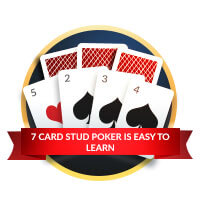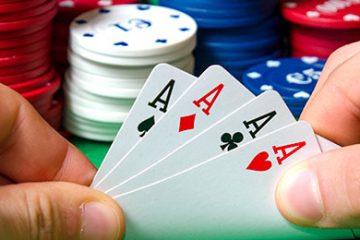There are many variations of poker, not just the popular Texas Hold’em, and they are all equally exciting. One such game is 7 card stud poker and it is enjoyed by millions of players all around the world.
7 card stud poker is a surprisingly easy game to learn. As with some other games of poker, the object of the game is to create the best possible five card hand from the seven cards you are dealt. Three cards are dealt face down and four are dealt face up, so it can be difficult to hide a good hand, although it’s great for terrible bluffers.
In this guide to seven-card stud, we’ll teach you the basics so you can get started playing this thrilling version of poker for real.
The Origins of 7 Card Stud Poker

It’s hard to remember a time when Texas Hold’em wasn’t the go to game for poker enthusiasts and there’s a good chance most people who play it now didn’t play poker at all before those days. Back then it was 7 card stud which was the poker game everyone wanted to play.
It has long been very popular in the States and is a game which can be played by anything from 2 to 8 players. It is brilliant in its simplicity in that each player has their own cards and there are no community cards. So many cards are dealt face up so you can see what your opponents have, or at least part of what they have.
Starting the Game
The initial deal in 7 card stud poker sees each player receive two cards face down and one face up. As in Hold’em the two face down cards are known as hole cards. The third face up card, is called the door card or third street. At this point you will decide whether or not you want to continue playing or if you want to fold.
The great thing about seven-card stud poker is that you can see some of your opponents’ cards. For instance if you have a pair of aces as your two face down cards you might think you’ve got a good hand to start with, but if another ace is showing as an opponent’s face up card or if in fact both aces are on the table as face up cards in different players’ hands, then it’s quite worthless and you basically just have a high card hand. You would probably want to fold at this point.
There is a round of betting at this point before each player receives their fourth street card face up. More betting follows and then the fifth street card is also dealt face up. Sixth street is played in exactly the same way and after one more round of betting each player receives their river card which is dealt face down.
Players will then bet and once this has been concluded and participating players’ hands are revealed, the dealer will declare a winner who scoops the pot.
Great Opening Hands
The first three cards a player is dealt can be a very good indicator of the chances of winning. Some hands are obviously better than others, but the following are hands you will definitely want to continue playing with:
Flush cards
Three cards of the same suit.

Straight cards
Cards that will form a straight, ideally an open ended straight. For example; 6, 7, 8 or J, Q, K.

High pocket pairs
Two of a kind, Jacks or better.

Rolled up trips
Three of a kind.

Betting in 7 Card Stud Poker
Each player must bet an ante in 7 card stud poker in order to be dealt cards. This is usually a nominal amount, such as $1 in a low stakes $10 low limit, $20 high limit game. The next level of bet is known as the bring-in. Once the first three cards are dealt, the hole cards and the door card, then the bring-in bet must be placed. The player who has the lowest ranking door card (aces are high) will post the bring-in bet and in this game it would be a $5 minimum – the maximum is the $10 low limit in a typical game.
If the player elects to only post the minimum bring-in then betting will continue clockwise and back to the initial player who can then increase the initial bring-in to the maximum for the game. Raising or betting continues until everyone has bet the same amount into the pot.
If the player who posts the bring-in bet stakes the maximum, then everyone else must match that to remain in the game and there would only be one round of betting before the fourth street card is dealt.
The betting for the fourth street round is conducted in the same way, but on fifth street and beyond the high limit can then be observed. It is still possible to keep the limit at $10, but once any player elects to raise to the high limit of $20 then that limit will be observed for the remainder of the hand. This will often happen once players start to assemble what they believe to be a winning hand.
Folding
You can fold at any point in 7 card stud poker. If you’re a good player you might be able to bluff, but there is no point in trying to win a hand with complete garbage. With four of your cards visible to all other players it can be quite a task trying to convince anyone that you’ve got a great hand when the evidence suggests otherwise – although nobody will know that the three cards they can’t see aren’t three of a kind.
You can’t win every hand, no matter how good a player you think you are, and sometimes it is best to just throw your cards away instead of throwing good money after bad. There’s always a chance to redeem yourself in the next hand.
You might see that all of your potential outs have vanished as the third, fourth, fifth and sixth street cards are played. Always fold in this instance.


0 Comments